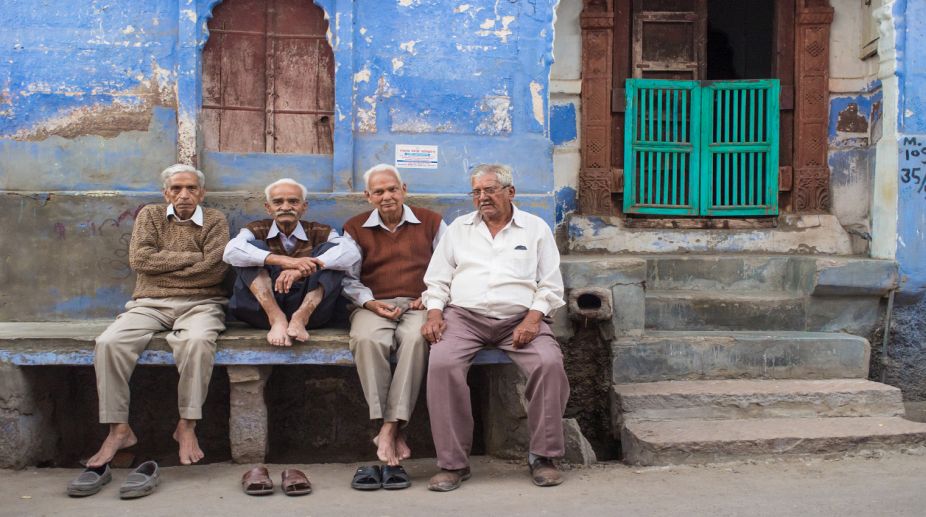Demographic transition is underway all over the world. In 2000, the number of children below 15 years was estimated
to be 3.3 times higher than those aged above 60. For the first time in history, the number of the aged is expected to exceed the number of young by 2050.
A United Nations report says that since 1950 the proportion of old persons in the total population has been rising steadily, from 8 per cent in 1950 to 11 per cent in 2007, and it is estimated to reach 22 per cent in 2050. Longer life spans, combined with families opting to have fewer children have led to the elderly becoming a growing proportion of the population.
For many years population ageing was considered to be a phenomenon of the developed countries of Europe and North America. At 21 per cent of the total population aged 60 years and above in 2009, the proportion of older persons in the more developed regions was much higher compared to the 8 per cent in developing regions.
However, both groupsare expected to have vastly increased proportions in the near future with 33 per cent and 20 per cent respectively in 2050. It is too big a number to be ignored by policymakers and social scientists across the world.
Presently, more than 60 per cent of the elderly live in less developed regions and Asia accounts for 55 per cent of them.
Moreover, the pace of population ageing is more rapid in developing countries than in developed countries and is taking place at lower levels of socio-economic development than has been the case of developed countries.
Also, in comparison to developed countries, developing countries have less time at their disposal to adjust to the consequences of population ageing.
In India, according to the 2011 population census the proportion of the population aged 60 years and above is 8.6 per cent and is projected to increase to 20 per cent by 2050.
This will have a huge impact on economic growth, labour market, consumption, social and welfare services, health care and demand for elderly housing etc. This picture of demographic transition in India also has another side attached to it. Youth migration (internal and international) for economic reasons has led to a drastic change in the living arrangements of the elderly in rural and urban areas.
In India, traditionally the joint family set-up took care of its elders, an arrangement now lost in the context of rapid urbanisation, migration and drift towards nuclear families. This whole trend has lead to a decreasing support base for the elderly. There is a large segment of elderly now living alone which has led to concern for their physical, economic,
psychological and social well-being.
Traditional alternatives based upon reciprocity and solidarity at the household or community levels are becoming unavailable because of the economic and social changes. There is a serious issue of ‘loneliness’ and ‘social isolation’ amongst the elderly living alone in this new socio-economic reality in India.
It is a very visible sight now to see the elderly struggling to manage their lives alone especially in the urban centres of the country. Although they suffer to some extent in rural parts also but the issues of loneliness and social isolation for them are not as severe as their counterparts face in the urban areas.
The reason is that relationships based on reciprocity and solidarity are still relatively stronger at the community level in
rural areas. Long periods of social isolation can have a negative impact on one’s physical, mental and social health.
The situation becomes more detrimental in the case of elderly people.
Thus a social network of meaningful personal relationships is crucial for them to feel socially secure. Various studies have indicated that the elderly are happiest when they stay active and maintain social interactions.
Unfortunately, State response in India to this new reality is largely negligent. However, in urban areas, it is not that the individuals or neighbourhood or communities are indifferent to the issues of elderly. Many have their best of intentions to help elderly, to offer company in their lonely lives but find themselves helpless, as no system is available to assistthem to put their noble intentions into action.
It is an issue which is going to affect each one of us sooner or later in life and thus cries out for constructive solutions. Government will always face resource crunches and thus instead of looking at government for help all the time it would be better to empower individuals and communities to help each other.
In this attempt government can work as a facilitator or communities themselves can take an initiative and thus take charge of the issues affecting their lives. However, there should be some successful models or examples available for them to show them the way on how to act to advance the social well-being of the lonely elderly in the community.
(The writer has done a Masters in Developmental Studies from the International Institute of Social Studies, Netherlands.)











